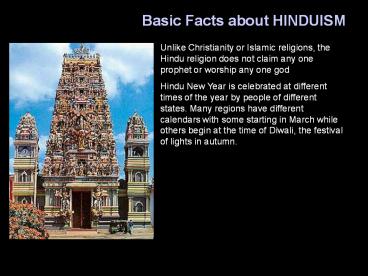Basic Facts about HINDUISM - PowerPoint PPT Presentation
Title:
Basic Facts about HINDUISM
Description:
Indian Vedic astrology is important to the conduct of any of life's important events such as marriage, ... all ascertained by Vedic mathematics and astrology. – PowerPoint PPT presentation
Number of Views:437
Avg rating:3.0/5.0
Title: Basic Facts about HINDUISM
1
Basic Facts about HINDUISM
Unlike Christianity or Islamic religions, the
Hindu religion does not claim any one prophet or
worship any one god Hindu New Year is celebrated
at different times of the year by people of
different states. Many regions have different
calendars with some starting in March while
others begin at the time of Diwali, the festival
of lights in autumn.
2
Basic Facts about HINDUISM
To many Hindus, the Vedas, a large body of texts
that originated in Ancient India, are the main
source of religious social and religious
practices in Hindu society. Indian Vedic
astrology is important to the conduct of any of
life's important events such as marriage,
applying for a post or admission, buying a house
or starting a new business. To millions of Hindus
the kundali is an invaluable possession that
charts the course of life for a man or a woman
from the time of his birth, all ascertained by
Vedic mathematics and astrology.
3
The Trimurti of Hinduism
VISHNU
BRAHMA
SHIVA
The Preserver
The Creator
The Destroyer
4
Vishnu - the Preserver
Vishnu as the All-Pervading essence of all
beings, the master of and beyond the past,
present and future, the creator and destroyer of
all existences, one who supports, sustains and
governs the Universe and originates and develops
all elements within. Vishnu is described as
being the colour of clouds (dark-blue),
four-armed, holding a lotus, mace, conch and
chakra (wheel). Vishnu is responsible for the
maintenance or 'preservation' of the Universe,
with the other roles of creation and destruction
being under the care of Brahma and Shiva,
respectively.
A 13th Century Cambodian sculpture of Vishnu
5
Shiva - the Destroyer
Shiva is commonly known as the God of Destruction
in Hinduism, but it is more appropriate to call
shiva the God or Regeneration. For while Shiva
does have aspects of destruction to his
character, he is also associated with
procreation. Infertile women will pray to this
representation in hopes of bearing children.
Other times Shiva is seen as the god of
meditation and asceticism. He will be depicted
sitting cross-legged with his eyes half-closed.
6
The Shiva Nataraja
This is the god Shiva dancing his cosmic dance.
It is believed that the energy from this dance
sustains the cosmos, and when Shiva is finished
with this dance, this universe will end and a new
one will begin. Shiva has a few special
characteristics, for example, the third eye in
his forehead. He stands in a circle of flames
with one foot on the demon Apasmaradurusa, who
symbolizes ignorance. He holds a drum in his
right hand, symbolizing the rhythm of the cosmic
dance. "Shiva Nataraja," or "Lord of the
Dance." Shiva dances the cosmic dance of
destruction on the body of the "dwarf of
ignorance."
Shiva Nataraja (The Dancing Shiva). Bronze
sculpture. Southern India, ca 1400.
7
(No Transcript)
8
Brahma - the Creator
Brahma is the Hindu god of creation. Although
Brahma is one of the major gods in Hinduism, few
Hindus actually worship him. India today has very
few temples dedicated to Brahma alone as opposed
to the thousands of temples dedicated to the
other deities in the Trimurti Shiva and Vishnu.
Brahma is traditionally depicted with four heads
and four faces and four arms. With each head he
continually recites one of the four Vedas. He is
often depicted with a white beard (especially in
North India), indicating the near eternal nature
of his existence. He is shown as having four
arms, with none holding a weapon, unlike most
other Hindu Gods.
9
(No Transcript)
10
Hindu Temples
A Hindu temple can be a separate structure or a
part of a building. A feature of most temples is
the presence of murtis of the Hindu deity to whom
the temple is dedicated. They are usually
dedicated to one primary deity, called the
presiding deity, and other subordinate deities
associated with the main deity. However, some
temples are dedicated to several deities, and
some have symbols instead of a murti.
11
Largest Hindu Temple in Britain
12
(No Transcript)
13
Ganesha The Elephant-headed God
Ganesh is the elephant headed god of Hindu myth.
He is known as the remover of obstacles, patron
of merchants and scholars. Ganesha is usually
depicted either as a pictograph or as an idol
with the body of a man and the head of an
elephant, having only one tusk, the other tusk
appearing broken. His unique feature, besides the
elephant head, is the large belly practically
falling over his lower garment. On his chest,
across his left shoulder, is his sacred thread,
often in the form of a snake.
14
(No Transcript)































